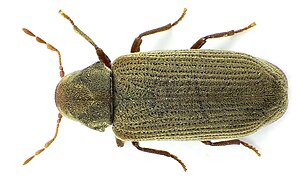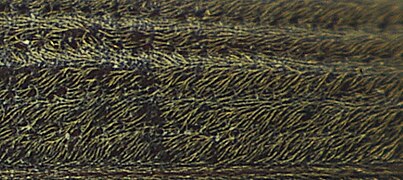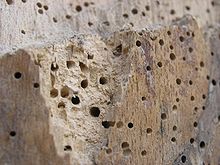Common rodent beetle
| Common rodent beetle | ||||||||||||
|---|---|---|---|---|---|---|---|---|---|---|---|---|

Common rodent beetle |
||||||||||||
| Systematics | ||||||||||||
|
||||||||||||
| Scientific name | ||||||||||||
| Anobium punctatum | ||||||||||||
| ( De Geer , 1774) |
The common or common rodent beetle ( Anobium punctatum ), colloquially also called woodworm because of the activity of the larvae , is a species of the rodent beetle (Ptinidae). The interpretation assigned to the knocking sound of the woodworm in mythology as a bad omen and omen of approaching death does not come from the common , but mostly from the pied rodent beetle .
The adult beetles are about 2.5 to 5 millimeters long. They are very rarely found in the wild, mostly on dry hardwood and coniferous wood, often under ivy ( Hedera helix ).
Characteristics of the beetle
The head is hidden under the pronotum (gallery, Figs. 1 and 2). The pronotum is humped almost like a hood. The antennae are eleven links, the last three links are greatly elongated. The middle links are rounded on the inner edge as well as on the outer edge (gallery, Fig. 5).
The antennae and legs can partially be inserted into a cavity between the middle hips. This hollow penetrates the entire mid-breast and most of the rear breast (gallery, Fig. 3). The first abdominal segment is longer than the third (gallery, Fig. 3).
The elytra are densely hairy and the hairs incline in such a way that stripes are formed (gallery, Fig. 4).
The safest way to separate the common rodent beetle from closely related species is to use a genital dissection.
The life cycle of the rodent beetle
The larvae of the rodent beetle infest built-in wood , i.e. not fresh wood (dry wood pest). The larvae hatch from the eggs laid in cracks or cracks in the wood and eat their way through the early wood . The latewood is spared and remains lamellar.
After several growth cycles, the adult larva pupates . After its transformation ( metamorphosis ), a sexually mature beetle hatches from the pupa. The exit holes from the wood are round and have a diameter of one to two millimeters. The hatched beetle is looking for a mate . After fertilization , the female rodent beetle lays its eggs in cracks, crevices and passages in the wood. Here the cycle continues. The development time of the larva takes a year under favorable conditions, up to eight years under unfavorable conditions. The hatching beetle likes to lay its eggs in the wood in which it grew up.
The rodent beetle is basically capable of flight and can look for new egg-laying places on the fly. The larvae feed on the sapwood . Heartwood is rarely attacked. If the larvae are active, this can be recognized by the wood flour oozing out. If you put black paper or something similar under the affected area, you can see wood dust on the paper after a few days of infestation activity. The period of a few days is necessary because the larvae occasionally take a break from eating.
The larva of the rodent beetle needs a minimum wood moisture of more than 10% and prefers cooler places - therefore it rarely occurs in centrally heated rooms. Critical areas are damp rooms or where floor cool / damp can occur. The infestation is not linked to a maximum age of the wood. The common rodent beetle can therefore also attack centuries-old wood.
Meaning as a wood-destroying insect
The common rodent beetle is the most important indigenous rodent beetle and is also widespread throughout Europe. In the case of art objects, furniture, musical instruments and everyday objects made of wood, it should be mentioned first as a wood-destroying insect. Since it finds its optimal development conditions in cool, damp rooms, furnishings in sacred buildings such as pews, altars, wooden figures and the like are particularly at risk. In areas with high humidity and moderate temperatures, roof structures, stables and similar objects are also infested.
See also
literature
- H. Joy, KW Harde, GA Lohse: The Beetles of Central Europe. Vol. 9. Spektrum Akademischer Verlag, Elsevier 1966, ISBN 3-8274-0683-8
- Jochen Müller: Wood protection in building construction. Fraunhofer IRB Verlag, Stuttgart 2005, ISBN 3-8167-6647-1
- Achim Unger: Wood conservation, protection and strengthening of wooden objects. Callway. Munich 1990. ISBN 978-3766709493
- Dietger Grosser: Plant and animal construction and timber pests. DRW-Verlag, 2005. ISBN 978-3871813399 . (1st edition: DRW.Leinfelden-Echterdingen
1985.)
- Hans-Peter Sutter: Recognizing and combating wood pests on cultural assets. Stuttgart 2002. ISBN 978-3258064437
- Bayer (Ed., Chemiewerk): Hygiene pests, pests, storage pests, material pests. Leverkusen 1997. (A previous edition: Bayer AG, 1989.)
- G. Becker: Observations on harmfulness, feeding and development time of Anobium punctatum De Geer (dead clock). Z. Pfl. Krank., 50: 1940, pp. 159-172.
- G. Becker: Ecological and physiological studies on wood-destroying larvae of Anobium punctatum De Geer. Z. Morph. Ökol. Animals, 39, 1942, pp. 98-152.
- G. Becker: Predators and parasites of wood-destroying insects in buildings . Negotiations of the German company f. angew. Entomol., 1954, pp. 76-86.
- S. Cymorek: Methods and experience in the cultivation of Anobium punctatum (De Geer). Wood as raw and material 33. 1975, pp. 239–246.
- S. Cymorek: Insect pests in works of art and antiques made of wood in Europe. In: Wood protection research and practice. Ed. Holzzentralblatt, 1982, pp. 37-56.
- P. Francke: Woodworm Infestation: Dead or Alive? - Comments on the occurrence of drilling dust after fumigation in churches. The practical pest controller, 53. 6/2001, pp. 15-21.
- NA Kemner: De ekonomiskt viktiga vedgnagande anobierna. Med. No. 108 Stockholm Entom. Avdeln. 1915, No. 19. 44 pp.
- W. Madel: Pests in Lumber. 1952, 103 pp.
- U. Noldt, T. Schönhoff, H. Michels: Examples and requirements for monitoring insect pests. In: DGfH Wood Protection Conference 2003 Augsburg, pp. 71–81
- R. Pospischil: Buntkäfer part 1. The practical pest controller, 52, 1/2000. Pp. 4-6.
- R. Pospischil: Buntkäfer part 2. The practical pest controller, 52, 2/2000. Pp. 4-6.
- R. Pospischil: The common rodent beetle. The practical pest controller, 52, 11/2000. Pp. 4-5.
- B. Ridout: Timber Decay in Buildings, The Conservation Approach to Treatment. English Heritage 2000, 232 pp.
- MJ Simmonds, SR Belmain, W. Blaney: Integrated pest management for the control of deathwatch beetles. In: English Heritage, Timber, The EC Woodcare Project: Studies of the behavior, interrelationships and management of deathwatch beetles in historic buildings. 2001, 114 pp.
- JP Vité: The wood-destroying insects of Central Europe. 156 p. Musterschmid. Goettingen 1952.
Web links
- Anobium punctatum in Fauna Europaea
- Fighting woodworms: what really helps against woodworms









